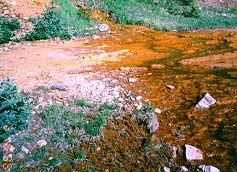How AMD is formed
AMD (Abandoned Mine Drainage) is created when water comes in contact with reactive minerals that have
been exposed through mining activities. The mineral responsible for the
vast majority of AMD formation is pyrite, often called fool's gold. A
pyrite molecule is comprised of one atom of iron and two atoms of sulfur (FeS2,
also known as iron sulfide). Pyrite reacts when it comes in contact with
water and oxygen. While in actuality a series of chemical reactions occur
to form contaminated water, the net result of these reactions can be summarized as follows:
Pyrite + water + oxygen reacts to form sulfuric acid + yellow boy
FeS2+ H2O + O2 --> H2SO4 + Fe(OH)3
For a more detailed look pyrite reactions, click here.
 Sulfuric acid
(H2SO4), a product of this reaction, is a strong acid
capable of having devastating environmental consequences for plants and animals.
Yellow boy (Fe(OH)3), also known as iron hydroxide, can form an orange or yellow sludge coating the bottoms of streams, effectively smothering aquatic life.
Sulfuric acid
(H2SO4), a product of this reaction, is a strong acid
capable of having devastating environmental consequences for plants and animals.
Yellow boy (Fe(OH)3), also known as iron hydroxide, can form an orange or yellow sludge coating the bottoms of streams, effectively smothering aquatic life.
If this weren't enough, the acidity generated by this reaction can further dissolve other minerals (such as clays) which can have high aluminum content as well as other metals. The contaminated water may thus carry a variety of pollutants. These pollutants in sufficiently high concentrations can have a variety of negative effects.
At some sites, the mineral limestone may also be present in the geologic strata. As contaminated water comes in contact with limestone, a beneficial reaction sometimes occurs. The limestone, also known as calcium carbonate (CaCO3), acts to counteract or neutralize the acidity generated by the pyrite reaction. The AMD may actually become alkaline. While it may still carry a variety of other contaminants, the impacts are not as far reaching as if the acidity were present.
See Acid Mine Drainage by Judi Todd and Kelli Reddick
Acid Mine Drainage, the Unseen Enemy by Walter D. Lawhorn